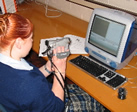Secondary 8
This activity was completed by a group of 23 Year 10 pupils representing a full mix in terms of gender and ability. The school is an 1116 co-educational comprehensive of around 900 pupils, situated just north of Portsmouth.
RE is taught in various rooms within the humanities faculty and is co-ordinated by the head of faculty, who is the only subject specialist. The GCSE Short Course is delivered by the head of faculty and two other humanities teachers.
The RE department is in its first year of teaching GCSE Short Course, RS for all. The course followed is WJEC’s Specification B (Christianity and Hinduism) and the lesson explained below was part of the Unit ‘Is it Fair?’ This unit is the second of five units that are studied in Year 10. RE is taught in a carousel with ICT (Short Course), with RE being allocated two thirds of the timetable time.
The lesson was carried out in a 16-station ICT suite; one computer per two students being the preferred model for this activity. The ‘President for a Day’ simulation (on CD-ROM) was saved onto the hard drive of the computers.
The teacher started the lesson by setting the focus. The class had been studying issues of justice and responsibility from Christian and Hindu perspectives. The class highlighted key words, their meanings and their importance, and a range of opinion and emphases were raised and recorded on the whiteboard.
The teacher then explained that pupils were to work in pairs and follow a computer simulation that would put them in the position of being president of a fictional African country for a day. They would have to make difficult decisions which would affect the lives of the people of their country, and should draw upon what they had learned in previous lessons to help them make wise decisions. The consequences of each decision they made would be revealed before they moved on to the next.
All pupils were familiar with working in the ICT suite, and there were few if any technical explanations needed on this occasion. Their full attention was quickly focused on the simulation, and all pupils were immediately and purposefully absorbed. The teacher was able to focus on discussion with each pair, questioning, probing, encouraging, and gaining insights into each individual’s degree of understanding which would be valuable in terms of assessment and future planning and task setting.
Ten minutes before the end of the lesson the pupils were asked to leave the simulation so that there could be feedback and reflection on what had been learned, and new questions and issues articulated for later comment and study.
Feedback was wide-ranging and thoughtful. It reflected a high level of engagement with the task which was perceived to be relevant to both their GCSE and real life. A potential follow-up task could be to ask pupils to work individually or in pairs to produce a 250-word answer to the following question:
'Consider the decisions you made during the simulation. Explain with reasons whether you think Hindu or Christian religious advisers to the president would have made the same decisions.'
During the project, pupils:
applied prior learning to an authentic situation represented in the simulation
demonstrated deeper understanding of the concepts studied (justice, responsibility, power, authority) and
their importance within the faiths studied (Christianity and Hinduism)
reflected on the consequences of the decision-making process for the individual and a community
identified, investigated and responded to fundamental questions of life raised by religious and human experience, including questions about the meaning and purpose of life
considered religious and other responses to moral issues
responded personally to the issues through reflecting, reasoning, weighing evidence and drawing conclusions
used their imaginations to consider other people’s experiences and thought about, expressed, explained and critically evaluated views that were not their own
identified unresolved questions and issues for further study and discussion
reflected on the process of participating
used ICT to enhance their learning and the quality of their work
used ICT effectively to explore develop and interpret information and solve problems in a variety of subjects and contexts.
How ICT enhanced teaching and learning
The lesson fully supported the delivery of RE learning intentions set by the teacher for the pupils. The use of ICT enabled the teacher to engage pupils in the process of applying prior learning and evaluating the consequences in a way that would not have been possible with the other resources available.
‘It makes you think about consequences.’
‘It is a great way to find out what it would be like to have such a responsibility.’
Using the simulation improved the quality and enjoyment of RE teaching and learning. The decision-making required was perceived as authentic by the pupils, both in terms of the requirements of their GCSE course and real life.
‘It makes what is really quite a serious subject fun!’
‘It is like real life and how to handle it.’
‘I liked deciding what to do; a whole country was depending on my decisions.’
The simulation was easy to enter and progress through, meaning that no time was lost through needing to provide technical explanations of the software. The ICT enhanced rather than hindered the learning process.
In any group of pupils there will be a range of preferred learning styles as well as abilities. The use of this simulation provided an opportunity to engage in a learning style which is of particular value to some members of the group, while being of benefit to all:
‘I would really recommend it to visual learners, like me!’
‘It was very good that you were given pictures of how things would turn out and bullet points to reinforce the points made.’
Opportunities were provided at the end to reflect both on the task and on how ICT had enabled the learning to take place.
Links and resources
Links to the National Curriculum in Action website - go

